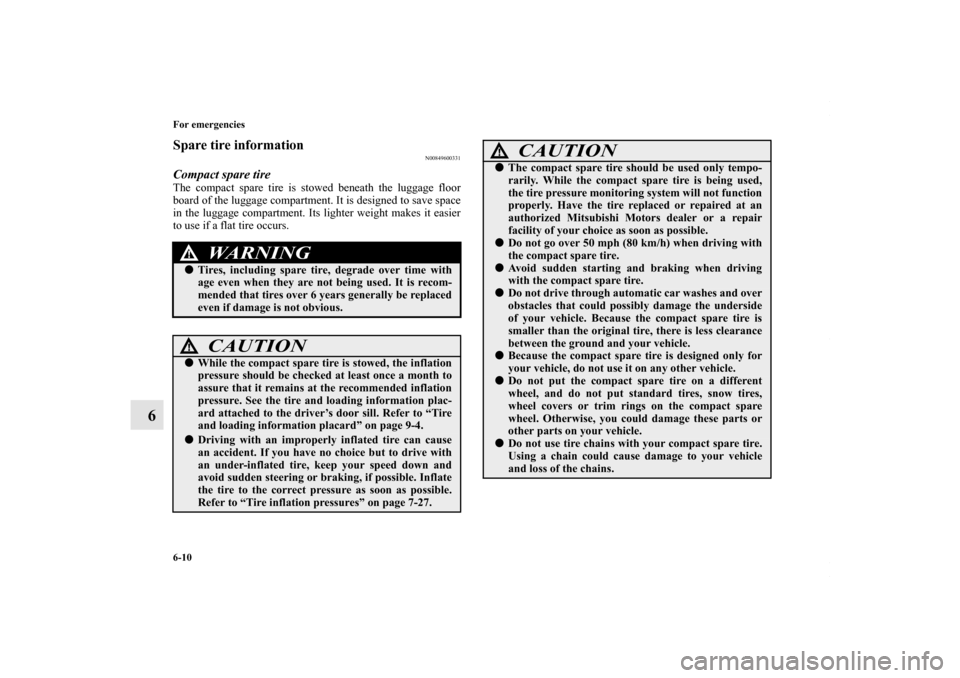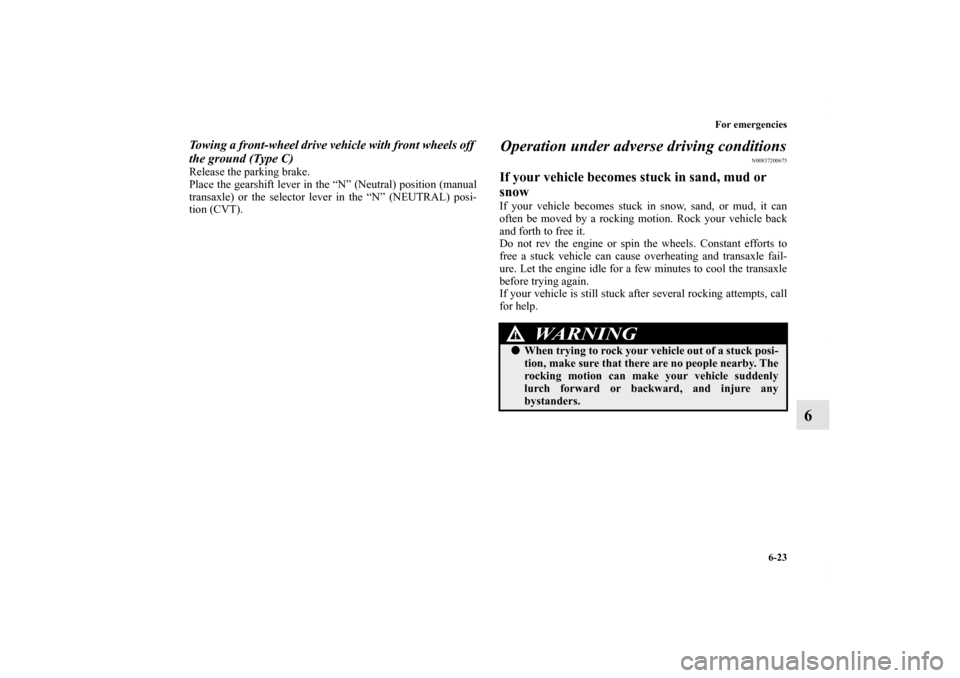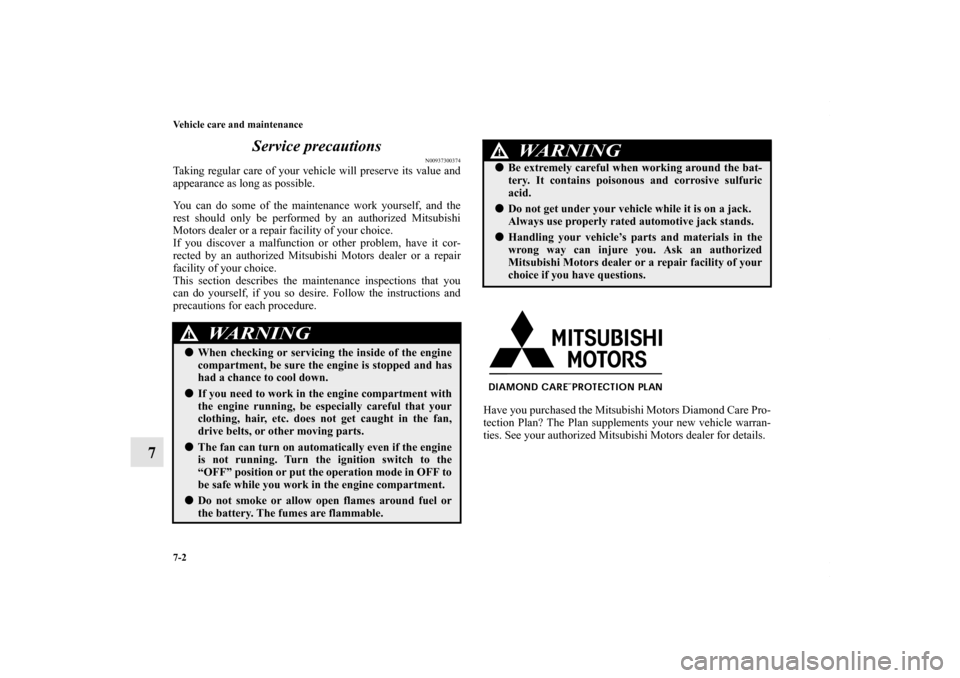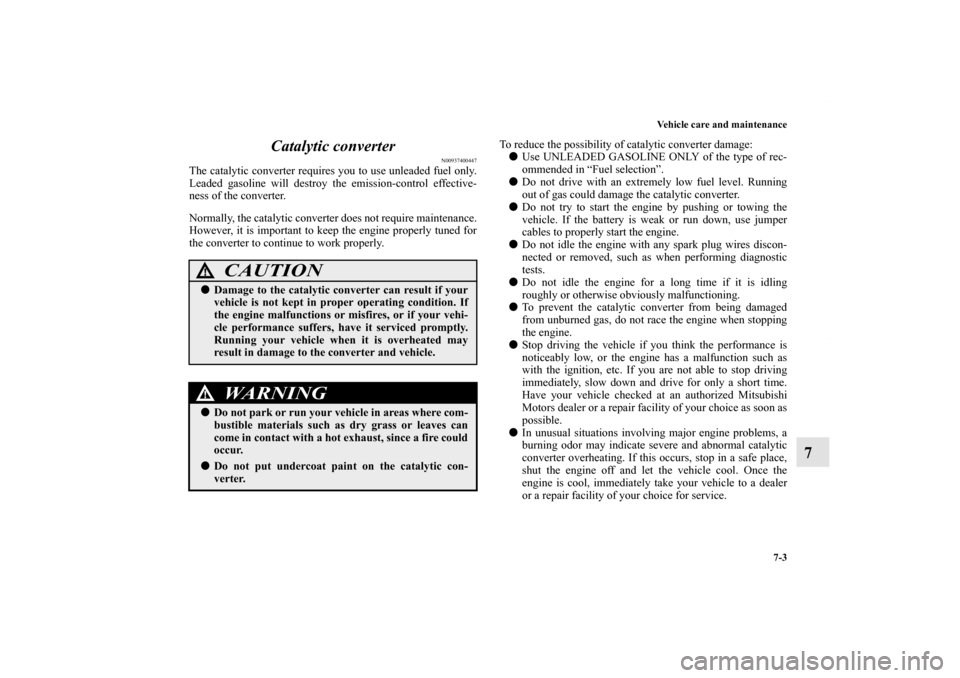Page 485 of 602

6-10 For emergencies
6
Spare tire information
N00849600331
Compact spare tireThe compact spare tire is stowed beneath the luggage floor
board of the luggage compartment. It is designed to save space
in the luggage compartment. Its lighter weight makes it easier
to use if a flat tire occurs.
WARNING
!�Tires, including spare tire, degrade over time with
age even when they are not being used. It is recom-
mended that tires over 6 years generally be replaced
even if damage is not obvious.
CAUTION
!�While the compact spare tire is stowed, the inflation
pressure should be checked at least once a month to
assure that it remains at the recommended inflation
pressure. See the tire and loading information plac-
ard attached to the driver’s door sill. Refer to “Tire
and loading information placard” on page 9-4.�Driving with an improperly inflated tire can cause
an accident. If you have no choice but to drive with
an under-inflated tire, keep your speed down and
avoid sudden steering or braking, if possible. Inflate
the tire to the correct pressure as soon as possible.
Refer to “Tire inflation pressures” on page 7-27.
� The compact spare tire should be used only tempo-
rarily. While the compact spare tire is being used,
the tire pressure monitoring system will not function
properly. Have the tire replaced or repaired at an
authorized Mitsubishi Motors dealer or a repair
facility of your choice as soon as possible.�Do not go over 50 mph (80 km/h) when driving with
the compact spare tire.�Avoid sudden starting and braking when driving
with the compact spare tire.�Do not drive through automatic car washes and over
obstacles that could possibly damage the underside
of your vehicle. Because the compact spare tire is
smaller than the original tire, there is less clearance
between the ground and your vehicle.�Because the compact spare tire is designed only for
your vehicle, do not use it on any other vehicle.�Do not put the compact spare tire on a different
wheel, and do not put standard tires, snow tires,
wheel covers or trim rings on the compact spare
wheel. Otherwise, you could damage these parts or
other parts on your vehicle.�Do not use tire chains with your compact spare tire.
Using a chain could cause damage to your vehicle
and loss of the chains.
CAUTION
!
BK0150700US.book 10 ページ 2012年3月22日 木曜日 午後6時46分
Page 487 of 602
6-12 For emergencies
6
2. Place the jack under one of the jacking points (A) shownin the illustration. Use the jacking point closest to the tire
you wish to change.
NOTE� Put the spare wheel under the vehicle body near the jack.
This makes it safer if the jack slips out of position.
WARNING
!�Set the jack only at the positions shown here. If the
jack is set at a wrong position, it could dent your
vehicle or the jack might fall over and cause per-
sonal injury.�Do not use the jack on a tilted or soft surface.
Otherwise, the jack might slip and cause personal
injury. Always use the jack on a flat, hard surface.
Before setting the jack, make sure there are no sand
or pebbles under the jack base.
BK0150700US.book 12 ページ 2012年3月22日 木曜日 午後6時46分
Page 488 of 602
For emergencies6-13
6
3. Rotate the jack by hand until the flange portion (B) fits inthe groove (C) at the top of the jack. 4. Insert the bar (D) into the wheel nut wrench (E). Then put
the end of the bar into the shaft’s jack end, as shown in the
illustration.
Slowly rotate the wheel nut wrench until the tire is raised
slightly off the ground surface.
WARNING
!� Stop jacking up the vehicle as soon as the tire is
raised off the ground. It is dangerous to raise the
vehicle any higher.�Do not get under your vehicle while using the jack.�Do not bump the raised vehicle or leave it sitting on
the jack for a long time. Both are very dangerous.�Do not use a jack except the one that came with your
vehicle.�The jack should not be used for any purpose other
than to change a tire.
BK0150700US.book 13 ページ 2012年3月22日 木曜日 午後6時46分
Page 489 of 602
6-14 For emergencies
6
5. Remove the wheel nuts with the wheel nut wrench, thentake the wheel off. 6. Clean out any mud, etc. on the hub surface (F), hub bolts
(G) or in the installation holes (H) in the wheel, and then
mount the spare tire.� No one should be in your vehicle when using the
jack.�Do not start or run the engine while your vehicle is
on the jack.�Do not turn the raised wheel. The tires that are still
on the ground could turn and make your vehicle fall
off the jack.
CAUTION
!�Handle the wheel carefully when changing the tire,
to avoid scratching the wheel surface.
WARNING
!
BK0150700US.book 14 ページ 2012年3月22日 木曜日 午後6時46分
Page 490 of 602
For emergencies6-15
6
7. [Vehicle with the tapered nuts]Install the wheel nuts with their tapered ends facing
inward, then tighten by hand until the wheel is no longer
loose.
WARNING
!� Mount the spare wheel with the valve stem (I) facing
outward. If you cannot see the valve stem (I), you
have installed the wheel backwards.
Operating the vehicle with the spare wheel installed
backwards can cause vehicle damage and result in
an accident.
BK0150700US.book 15 ページ 2012年3月22日 木曜日 午後6時46分
Page 498 of 602

For emergencies6-23
6
Towing a front-wheel drive vehicle with front wheels off
the ground (Type C)Release the parking brake.
Place the gearshift lever in the “N” (Neutral) position (manual
transaxle) or the selector lever in the “N” (NEUTRAL) posi-
tion (CVT).
Operation under adverse driving conditions
N00837200675
If your vehicle becomes stuck in sand, mud or
snowIf your vehicle becomes stuck in snow, sand, or mud, it can
often be moved by a rocking motion. Rock your vehicle back
and forth to free it.
Do not rev the engine or spin the wheels. Constant efforts to
free a stuck vehicle can cause overheating and transaxle fail-
ure. Let the engine idle for a few minutes to cool the transaxle
before trying again.
If your vehicle is still stuck after several rocking attempts, call
for help.
WARNING
!�When trying to rock your vehicle out of a stuck posi-
tion, make sure that there are no people nearby. The
rocking motion can make your vehicle suddenly
lurch forward or backward, and injure any
bystanders.
BK0150700US.book 23 ページ 2012年3月22日 木曜日 午後6時46分
Page 503 of 602

7-2 Vehicle care and maintenance
7Service precautions
N00937300374
Taking regular care of your vehicle will preserve its value and
appearance as long as possible.
You can do some of the maintenance work yourself, and the
rest should only be performed by an authorized Mitsubishi
Motors dealer or a repair facility of your choice.
If you discover a malfunction or other problem, have it cor-
rected by an authorized Mitsubishi Motors dealer or a repair
facility of your choice.
This section describes the maintenance inspections that you
can do yourself, if you so desire. Follow the instructions and
precautions for each procedure.
Have you purchased the Mitsubishi Motors Diamond Care Pro-
tection Plan? The Plan supplements your new vehicle warran-
ties. See your authorized Mitsubishi Motors dealer for details.
WARNING
!�When checking or servicing the inside of the engine
compartment, be sure the engine is stopped and has
had a chance to cool down.�If you need to work in the engine compartment with
the engine running, be especially careful that your
clothing, hair, etc. does not get caught in the fan,
drive belts, or other moving parts.�The fan can turn on automatically even if the engine
is not running. Turn the ignition switch to the
“OFF” position or put the operation mode in OFF to
be safe while you work in the engine compartment.�Do not smoke or allow open flames around fuel or
the battery. The fumes are flammable.
� Be extremely careful when working around the bat-
tery. It contains poisonous and corrosive sulfuric
acid.�Do not get under your vehicle while it is on a jack.
Always use properly rated automotive jack stands.�Handling your vehicle’s parts and materials in the
wrong way can injure you. Ask an authorized
Mitsubishi Motors dealer or a repair facility of your
choice if you have questions.
WARNING
!
BK0150700US.book 2 ページ 2012年3月22日 木曜日 午後6時46分
Page 504 of 602

Vehicle care and maintenance7-3
7
Catalytic converter
N00937400447
The catalytic converter requires you to use unleaded fuel only.
Leaded gasoline will destroy the emission-control effective-
ness of the converter.
Normally, the catalytic converter does not require maintenance.
However, it is important to keep the engine properly tuned for
the converter to continue to work properly.
To reduce the possibility of catalytic converter damage:
� Use UNLEADED GASOLINE ONLY of the type of rec-
ommended in “Fuel selection”.
� Do not drive with an extremely low fuel level. Running
out of gas could damage the catalytic converter.
� Do not try to start the engine by pushing or towing the
vehicle. If the battery is weak or run down, use jumper
cables to properly start the engine.
� Do not idle the engine with any spark plug wires discon-
nected or removed, such as when performing diagnostic
tests.
� Do not idle the engine for a long time if it is idling
roughly or otherwise obviously malfunctioning.
� To prevent the catalytic converter from being damaged
from unburned gas, do not race the engine when stopping
the engine.
� Stop driving the vehicle if you think the performance is
noticeably low, or the engine has a malfunction such as
with the ignition, etc. If you are not able to stop driving
immediately, slow down and drive for only a short time.
Have your vehicle checked at an authorized Mitsubishi
Motors dealer or a repair facility of your choice as soon as
possible.
� In unusual situations involving major engine problems, a
burning odor may indicate severe and abnormal catalytic
converter overheating. If this occurs, stop in a safe place,
shut the engine off and let the vehicle cool. Once the
engine is cool, immediately take your vehicle to a dealer
or a repair facility of your choice for service.
CAUTION
!�Damage to the catalytic converter can result if your
vehicle is not kept in proper operating condition. If
the engine malfunctions or misfires, or if your vehi-
cle performance suffers, have it serviced promptly.
Running your vehicle when it is overheated may
result in damage to the converter and vehicle.
WARNING
!�Do not park or run your vehicle in areas where com-
bustible materials such as dry grass or leaves can
come in contact with a hot exhaust, since a fire could
occur.�Do not put undercoat paint on the catalytic con-
verter.
BK0150700US.book 3 ページ 2012年3月22日 木曜日 午後6時46分